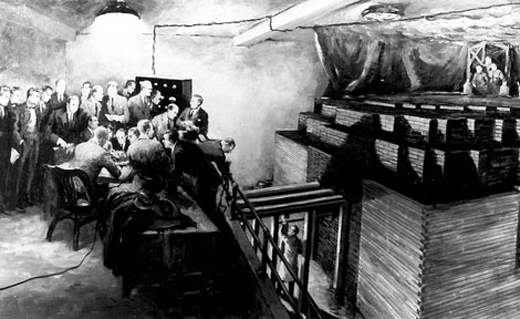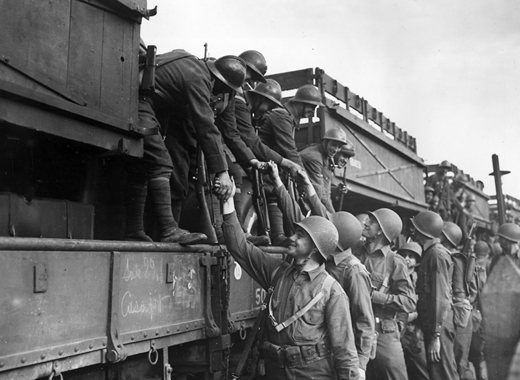Air Operations, Europe
BOMBER COMMANDEvening Ops:
- 112 aircraft are sent to Frankfurt: 48 Halifaxes, 27 Lancasters, 22 Stirlings and 15 Wellingtons.
- There is thick haze and the Pathfinders do not locate Frankfurt; most of the bomb loads fall in the country southwest of the city.
- 3 Halifaxes, 1 Lancaster, 1 Stirling and 1 Wellington are lost.
- There are 4 OTU sorties without a loss.
Air Operations, New Guinea
V Bomber Command B-17s, B-25s, and A-20s, and 35th Fighter Group P-400s force 4 Japanese destroyer-transports to land 800 Japanese Army troops much farther than intended from the hard-pressed Japanese defensive positions at Gona. Also attacked are Japanese Army defensive positions at Buna, the airfield at Buna, and various targets between Cape Killerton and Watutu Point.
[Air Operations, Tunisia
- 12th Air Force A-20s, followed by B-26s, attack Tunis/El Aouina Airdrome.
- 12th Air Force B-17s attack Bizerte/Sidi Ahmed Airdrome and Bizerte harbor.
- 12th Air Force B-25s attack the flak batteries near Gabes Airdrome.
- A total of 9 Luftwaffe fighters are downed during the day by pilots of the 1st, 14th, and 52nd Fighter Groups in a number of escort missions and aggressive sweeps into enemy territory.
Atomic Research
The first man-made, self-sustaining chain reaction, fission of the uranium isotope U-238, is achieved in the atomic pile at Chicago University. Under the direction of physicists Arthur Compton and Enrico Fermi, an antifascist Italian who fled his native country, a chain reaction is initiated in a makeshift laboratory under the University of Chicago football stadium.
The First Self-sustaining Fission Reaction |
 |
Battle of the Atlantic
The US steamship Coamo is torpedoed and sunk by U-604 off Bermuda. Some survivors of the 186 men on board manage to escape on rafts only to perish in a gale that is in the area the following day.
[Eastern Front
NORTHERN SECTORThe Leningrad and Volkhov Fronts receive orders to launch Operation ISKRA at the beginning of January 1943. This operation is intended to break the siege around the city.
SOUTHERN SECTORFighting along the Chir intensifies as the 5th Tank Army pins the XLVIII Panzer down. Battles rage at Oblivskaya, Surovokino and Nizhne Chirskaya. To support the 5th Tank Army the Stavka orders the 5th Shock Army up to the Chir Front. It will arrive in a week's time. The 51st Army is involved in costly fighting around Kotelnikovo. Around Stalingrad, the 21st, 66th and 24th Armies attack the 6th Army perimeter.
[Guadalcanal
US Marines ambush a Japanese patrol around the Lunga River, killing 35 of the 60 enemy soldiers.
[Italy, Home Front
Mussolini breaks his 18-month silence to refute Churchill's broadcast of November 29. He also reports Italian casualties after 30 months of war: 40,210 killed; 35,964 wounded; 233,778 prisoners; and 38,513 missing.
[Mediterranean
- British Force Q of light cruisers Aurora, Sirius and Argonaut with destroyers Quiberon and Quentin intercept a convoy that had departed Palermo on the 1st heading for Bizerte. All 4 steamers of the convoy are sunk about 40 miles north of Cape Bon. They are the Italian Aventino (3,794t), the Italians Puccini (2422t), the German KT-1 (760t) and the Italian Aspromonte (976t). Escorts damaged in the action are the destroyer Da Recco and the torpedo boat Procione. Returning to Bône the Quentin is sunk by an aircraft torpedo north of Algiers with the loss of 10 of her crew. The Quiberon picks up the survivors.
- The Italian steamer Veloce (5451t) is damaged by an aircraft torpedo about 20 miles off Kerkennah, Tunisia. The Italian torpedo boat Lupo, assisting the steamer, is surprised by the British destroyers Jervis, Javelin, Janus and Kelvin. Both Italian ships are sunk. The Italian torpedo boat Ardente rescues the survivors.
New Guinea
The Australians capture part of the Gona defenses. A further Japanese reinforcement convoy of 4 destroyers tries to land at Basabua at dawn but is turned away by air attacks. The troops, around 800 strong however, are landed along the coast to the west near the mouth of the Kumusi River some 12 miles north of Gona. Japanese units attack the road-block on the Soputa-Sanananda track and succeed in reducing its perimeter, but not in breaking through it. Allied attacks against Buna collapse a little away from their objective.
Gen Robert L. Eichelberger has been sent by MacArthur to investigate the lack of progress at Buna and he decides to relieve Gen Edwin F. Harding of command of the US forces there. He is replaced by Gen Blake D. Waldron. Up to this time 15,000 Australians and 15,000 Americans, despite their complete mastery of the air, and consequently largely of the sea as well, have not been able to overcome 12,000 Japanese.
[North Africa
TUNISIAThe British 1st Army beats back another German attack on Tebourba, losing about 40 tanks. The 2nd Battalion, 509th Parachute Regiment and the 3rd Battalion, 26th Regimental Combat Team, US 1st Div, along with French units, attack Faïd Pass, 62 miles northeast of Gafsa in eastern central Tunisia.
French Troops on Their Way to the Front |
 |